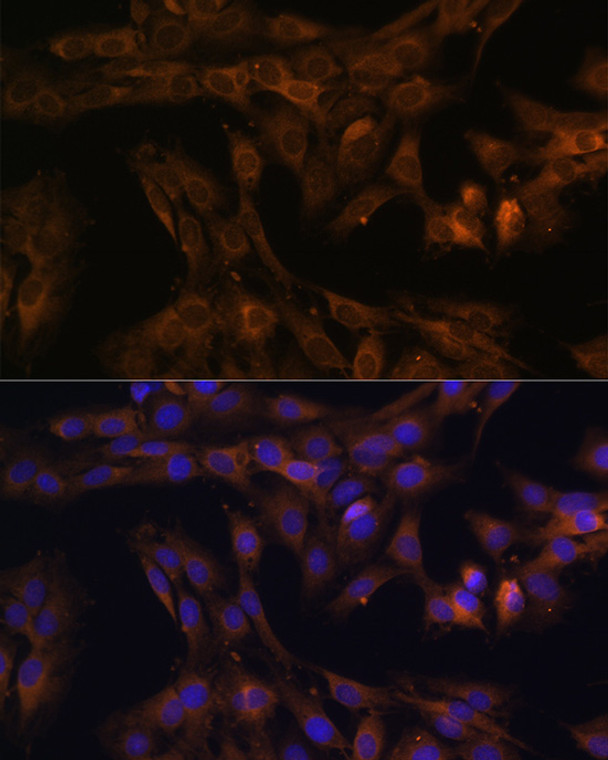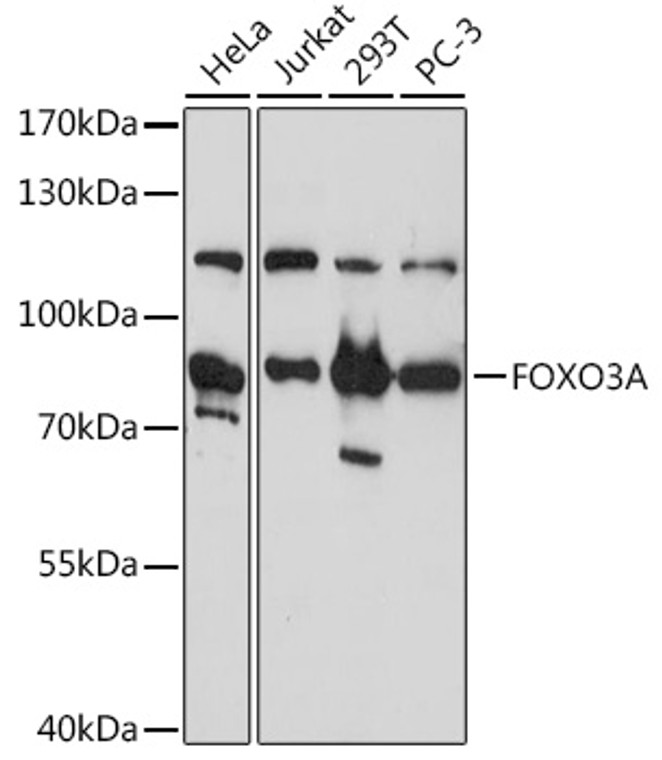| Host: |
Rabbit |
| Applications: |
WB/IHC/IF |
| Reactivity: |
Human/Mouse/Rat |
| Note: |
STRICTLY FOR FURTHER SCIENTIFIC RESEARCH USE ONLY (RUO). MUST NOT TO BE USED IN DIAGNOSTIC OR THERAPEUTIC APPLICATIONS. |
| Short Description: |
Rabbit polyclonal antibody anti-FoxO3a (558-672) is suitable for use in Western Blot, Immunohistochemistry and Immunofluorescence research applications. |
| Clonality: |
Polyclonal |
| Conjugation: |
Unconjugated |
| Isotype: |
IgG |
| Formulation: |
PBS with 0.02% Sodium Azide, 50% Glycerol, pH7.3. |
| Purification: |
Affinity purification |
| Dilution Range: |
WB 1:500-1:1000IHC-P 1:50-1:200IF/ICC 1:50-1:200 |
| Storage Instruction: |
Store at-20°C for up to 1 year from the date of receipt, and avoid repeat freeze-thaw cycles. |
| Gene Symbol: |
Foxo3 |
| Gene ID: |
56484 |
| Uniprot ID: |
FOXO3_MOUSE |
| Immunogen Region: |
558-672 |
| Immunogen: |
Recombinant fusion protein containing a sequence corresponding to amino acids 558-672 of mouse FOXO3A (NP_062714.1). |
| Immunogen Sequence: |
LSDSSSLGSAKHQQQSPASQ SMQTLSDSLSGSSLYSASAN LPVMGHDKFPSDLDLDMFNG SLECDMESIIRSELMDAD |
| Tissue Specificity | Expressed in white and brown adipose tissues (at protein level). Expressed in liver, kidney, lung and colon (at protein level). Expressed in skeletal muscles (at protein level). |
| Post Translational Modifications | Deacetylation by SIRT1 or SIRT2 stimulates interaction of FOXO3 with SKP2 and facilitates SCF(SKP2)-mediated FOXO3 ubiquitination and proteasomal degradation. Deacetylation by SIRT2 stimulates FOXO3-mediated transcriptional activity in response to oxidative stress. Deacetylated by SIRT3. Deacetylation by SIRT3 stimulates FOXO3-mediated mtDNA transcriptional activity in response to metabolic stress. In the presence of survival factors such as IGF-1, phosphorylated on Thr-32 and Ser-252 by AKT1/PKB (Probable). This phosphorylated form then interacts with 14-3-3 proteins and is retained in the cytoplasm (Probable). Survival factor withdrawal induces dephosphorylation and promotes translocation to the nucleus where the dephosphorylated protein induces transcription of target genes and triggers apoptosis. Although AKT1/PKB doesn't appear to phosphorylate Ser-314 directly, it may activate other kinases that trigger phosphorylation at this residue. Phosphorylated by STK4/MST1 on Ser-208 upon oxidative stress, which leads to dissociation from YWHAB/14-3-3-beta and nuclear translocation. Phosphorylated by PIM1. Phosphorylation by AMPK leads to the activation of transcriptional activity without affecting subcellular localization. Phosphorylated by AMPK on Ser-30 in response to metabolic stress which mediates FOXO3 mitochondrial translocation. Phosphorylation by MAPKAPK5 promotes nuclear localization and DNA-binding, leading to induction of miR-34b and miR-34c expression, 2 post-transcriptional regulators of MYC that bind to the 3'UTR of MYC transcript and prevent its translation. Phosphorylated by CHUK/IKKA and IKBKB/IKKB. TNF-induced inactivation of FOXO3 requires its phosphorylation at Ser-643 by IKBKB/IKKB which promotes FOXO3 retention in the cytoplasm, polyubiquitination and ubiquitin-mediated proteasomal degradation. May be dephosphorylated by calcineurin A on Ser-298 which abolishes FOXO3 transcriptional activity. Phosphorylation at Ser-252 promotes its degradation by the proteasome. Dephosphorylation at Ser-252 by protein phosphatase 2A (PPP2CA) promotes its stabilization.interaction with PPP2CA is enhanced by AMBRA1. Heavily methylated by SET9 which decreases stability, while moderately increasing transcriptional activity. The main methylation site is Lys-270. Methylation doesn't affect subcellular location. Polyubiquitinated. Ubiquitinated by a SCF complex containing SKP2, leading to proteasomal degradation. The N-terminus is cleaved following import into the mitochondrion. |
| Function | Transcriptional activator that recognizes and binds to the DNA sequence 5'-AGTAAATCA-3' and regulates different processes, such as apoptosis and autophagy. Acts as a positive regulator of autophagy in skeletal muscle: in starved cells, enters the nucleus following dephosphorylation and binds the promoters of autophagy genes, such as GABARAP1L, MAP1LC3B and ATG12, thereby activating their expression, resulting in proteolysis of skeletal muscle proteins. Triggers apoptosis in the absence of survival factors, including neuronal cell death upon oxidative stress. Participates in post-transcriptional regulation of MYC: following phosphorylation by MAPKAPK5, promotes induction of miR-34b and miR-34c expression, 2 post-transcriptional regulators of MYC that bind to the 3'UTR of MYC transcript and prevent its translation. In response to metabolic stress, translocates into the mitochondria where it promotes mtDNA transcription. Also acts as a key regulator of chondrogenic commitment of skeletal progenitor cells in response to lipid availability: when lipids levels are low, translocates to the nucleus and promotes expression of SOX9, which induces chondrogenic commitment and suppresses fatty acid oxidation. Also acts as a key regulator of regulatory T-cells (Treg) differentiation by activating expression of FOXP3. |
| Protein Name | Forkhead Box Protein O3 |
| Database Links | Reactome: R-MMU-1181150Reactome: -MMU-198693Reactome: -MMU-5687128Reactome: -MMU-9607240Reactome: -MMU-9614399Reactome: -MMU-9617629Reactome: -MMU-9617828Reactome: -MMU-9634638 |
| Cellular Localisation | CytoplasmCytosolNucleusMitochondrion MatrixMitochondrion Outer MembranePeripheral Membrane ProteinCytoplasmic SideRetention In The Cytoplasm Contributes To Its InactivationTranslocates To The Nucleus Upon Oxidative Stress And In The Absence Of Survival FactorsTranslocates From The Cytosol To The Nucleus Following Dephosphorylation In Response To Autophagy-Inducing StimuliTranslocates In A Ampk-Dependent Manner Into The Mitochondrion In Response To Metabolic StressSerum Deprivation Increases Localization To The NucleusLeading To Activate Expression Of Sox9 And Subsequent Chondrogenesis |
| Alternative Antibody Names | Anti-Forkhead Box Protein O3 antibodyAnti-Foxo3 antibodyAnti-Fkhr2 antibodyAnti-Foxo3a antibody |
Information sourced from Uniprot.org
12 months for antibodies. 6 months for ELISA Kits. Please see website T&Cs for further guidance









